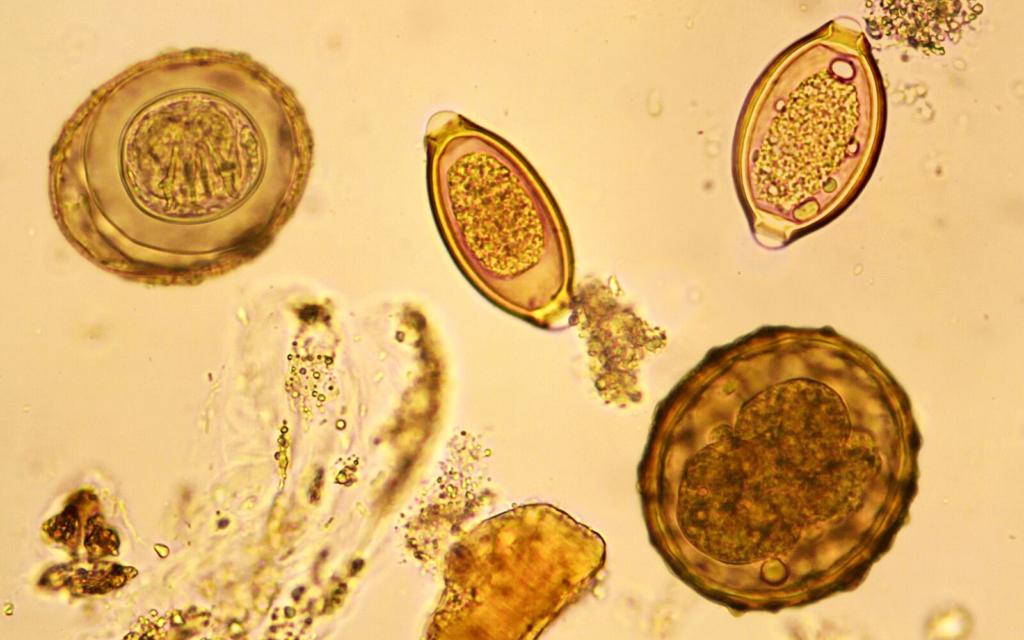
Table of Contents
What is Parasitology?
Parasitology is the branch of biology and medicine that studies parasites, their hosts, and the relationship between them. It encompasses the study of the biology, ecology, and pathogenesis of parasites, as well as their life cycles, epidemiology, diagnosis, treatment, and prevention.

Definition:
Parasitology: The scientific study of parasites, their biology, their host interactions, and the diseases they cause.
Classification:
Parasites are typically classified into three major groups:
Protozoa: Single-celled organisms that can cause diseases like malaria, amoebiasis, and giardiasis.
Helminths: Multicellular worms such as:
- Nematodes (roundworms) like Ascaris lumbricoides.
- Cestodes (tapeworms) like Taenia solium.
Ectoparasites: Organisms such as lice, fleas, and ticks that live on the surface of the host and can cause or transmit diseases.
Life Cycles:
Parasites have complex life cycles that often involve multiple hosts. The life cycle stages can include:
- Egg: The initial stage, often shed into the environment by the host.
- Larva: An immature form that undergoes several developmental stages.
- Adult: The mature, reproductive stage that typically causes the most damage to the host.

Pathogenesis:
Pathogenesis refers to the process by which a parasite causes disease in its host. This can occur through:
- Direct damage: Physical damage to tissues and organs.
- Nutrient depletion: Stealing nutrients from the host.
- Immune response: Triggering harmful immune responses.
- Toxin production: Producing toxins that harm the host.
Epidemiology:
Epidemiology is the study of how parasitic diseases spread and are distributed in populations. Key aspects include:
- Transmission routes: How the parasite spreads (e.g., water, food, vectors, direct contact).
- Risk factors: Conditions that increase the likelihood of infection (e.g., poor sanitation, climate, socioeconomic factors).
- Incidence and prevalence: The rate of new and existing cases in a population.
Laboratory Diagnosis:
Diagnosing parasitic infections involves various methods, including:
- Microscopy: Examining samples (e.g., blood, stool) for parasites.
- Serology: Detecting antibodies or antigens related to the parasite.
- Molecular techniques: Using PCR to detect parasite DNA.
- Imaging: Utilizing techniques like ultrasound or MRI to identify parasite-induced damage.

Treatment:
Treating parasitic infections involves antiparasitic drugs. The choice of drug depends on the type of parasite and the specific infection.
Drugs of Choice:
Protozoa:
- Malaria: Artemisinin-based combination therapies (ACTs).
Helminths:
- Ascariasis: Albendazole or Mebendazole.
Prevention Guidelines by WHO:
The World Health Organization (WHO) provides comprehensive guidelines for the prevention of parasitic infections:
- Sanitation and Hygiene: Improving water and sanitation facilities to reduce the spread of parasites.
- Vector Control: Using insecticide-treated bed nets, indoor residual spraying, and environmental management to control vector-borne diseases like malaria.
- Health Education: Raising awareness about parasitic infections and promoting practices to prevent them.
- Mass Drug Administration (MDA): Distributing antiparasitic drugs to at-risk populations to reduce the prevalence of infections.
- Vaccination: Developing and deploying vaccines against parasitic diseases where applicable.
- Surveillance and Monitoring: Tracking the incidence and prevalence of parasitic infections to inform and improve control measures.
FAQs about Parasitology:
1. What is parasitology?
Parasitology is the scientific study of parasites, their hosts, and the relationship between them. It covers the biology, pathology, and ecology of parasitic organisms.
2. What are parasites?
Parasites are organisms that live on or inside a host organism, deriving nutrients at the host’s expense. They can be protozoa, helminths (worms), ectoparasites (such as lice and ticks), and others.
3. What are the different types of parasites?
- Protozoa: Single-celled organisms (e.g., Plasmodium, which causes malaria).
- Helminths: Multicellular worms (e.g., tapeworms, roundworms).
- Ectoparasites: Parasites that live on the surface of the host (e.g., fleas, lice).
- Endoparasites: Parasites that live inside the host (e.g., intestinal worms).
4. How are parasitic infections diagnosed?
Diagnosis can involve various methods, including:
- Microscopic examination of blood, stool, or tissue samples.
- Serological tests to detect antibodies or antigens.
- Molecular techniques such as PCR (Polymerase Chain Reaction).
- Imaging techniques like MRI or CT scans in certain cases.
5. How do parasites affect their hosts?
Parasites can cause a wide range of effects, from minor irritation to severe diseases. They can damage tissues, cause immune responses, deprive the host of nutrients, and in some cases, be fatal.
6. How are parasitic infections treated?
Treatment depends on the type of parasite and may include:
- Antiparasitic medications (e.g., antimalarials, anthelmintics).
- Supportive care to manage symptoms.
- Sometimes surgical intervention to remove parasites or repair damage.
7. How can parasitic infections be prevented?
Prevention strategies include:
- Good hygiene practices, such as regular handwashing.
- Use of insect repellent and protective clothing to avoid bites.
- Vaccination (where available).
- Deworming programs in areas with high prevalence.
8. Why is parasitology important in public health?
Parasitology is crucial for understanding and controlling parasitic diseases, which can have significant health, economic, and social impacts. It helps in developing effective prevention, diagnosis, and treatment strategies.
9. What are some common parasitic diseases?
Some common parasitic diseases include:
- Malaria
- Giardiasis
- Toxoplasmosis
- Schistosomiasis
- Ascariasis
- Leishmaniasis
10. How do parasites adapt to their hosts?
Parasites have various adaptations to evade the host’s immune system, exploit the host’s resources, and ensure their own reproduction. These adaptations can include complex life cycles, antigenic variation, and specialized feeding mechanisms.
11. Can parasites affect animals and plants too?
Yes, parasites can infect a wide range of hosts, including animals (both domestic and wild) and plants, causing significant health and economic impacts in agriculture and wildlife management.
12. What is the role of parasitologists?
Parasitologists conduct research to understand parasitic diseases, develop diagnostic methods, and create treatments and preventive measures. They may work in academia, healthcare, public health, agriculture, and environmental sciences.
13. What are zoonotic parasites?
Zoonotic parasites are those that can be transmitted from animals to humans. Examples include Toxoplasma gondii (from cats) and various helminths from livestock.
14. How does climate change impact parasitology?
Climate change can alter the distribution and prevalence of parasites and their vectors (such as mosquitoes), potentially leading to the spread of parasitic diseases to new regions.
